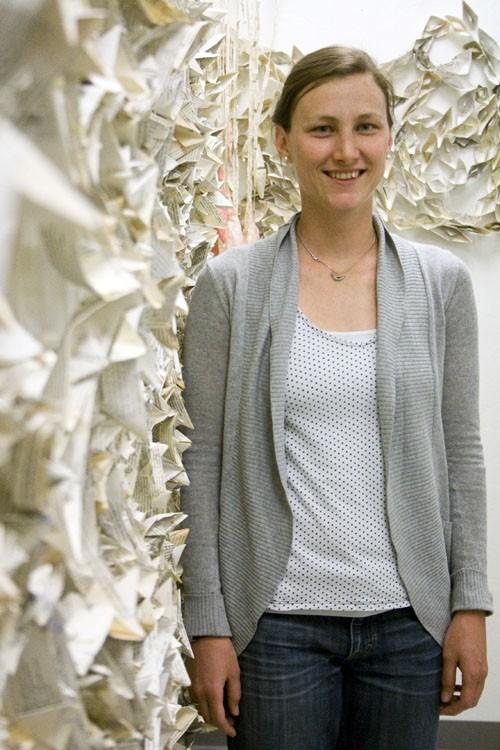Homer’s “”The Odyssey”” is one of the oldest stories of all time. But Sarah Zidonik has found a way to bring this classical epic into the present moment.
Zidonik is a graduate student pursuing a Masters of Fine Arts in studio art. She holds an undergraduate degree in art with an emphasis in printmaking and now experiments with many different media. For the past several months, Zidonik has been working with actual book pages from “”The Odyssey”” as an artistic medium.
“”My idea began with ‘The Odyssey’ as a journey and searching for the idea of home,”” Zidonik said. “”I have 25 copies of ‘The Odyssey’ with the pages cut out. I’m folding (the pages) into paper boats, then sewing (the boats) together.””
Ultimately, Zidonik’s boats will form a standing artistic structure complete with entry portals. “”I’m going to call it ‘an architecture of belonging,'”” Zidonik said.
There are three elements to Zidonik’s idea. Although most of her paper boats are made from ‘The Odyssey,’ she has also asked friends, family and fellow UA students to create their own paper boats. Zidonik provides contributors with onion-skin typewriter paper and asks them to handwrite a personal story. She estimates that by the end of her project, she will acquire about 300 original stories, which will be worked into the structure alongside the boats made from book pages.
The third element of Zidonik’s project is her rewriting of “”The Odyssey.”” She begins with pages from the book, and then alters the story by drawing and painting on them. Zidonik covers many of the words completely, leaving poetic fragments of sentences and phrases. The complete “”Paper Boat Odyssey”” will debut on April 15 at the University of Arizona Museum of Art, with a reception April 21.
Wildlife had a chance to speak with Zidonik last week in her studio at the Visual Arts Graduate Research Laboratory. Flanked by an armada of paper boats, structural ideas and pages of “”The Odyssey”” tacked to the walls, Zidonik shared her inspiration and goals for the project.
Can you tell me about working with pages of books as a medium?
I’ve always loved books. I’ve been interested in using actual book pages to draw on top of for a while now. And in the boat form, when there’s not painting on top of it, I love looking at the texture. Also, we know those are words — they mean something if you read them. They contain so much story and experience. It’s fun to imagine all those words and the stories they tell when you see the text.
So, we can’t actually read the text on the boats, but we know it’s there. Is this part of the significance of your artwork?
Yeah. I figure that with so many boats, it’s almost hard to even read a singular boat. And there’s so many of them. It’s the same kind of thing with the text — it’s hard to read individual words, but I want the words to convey the feeling of language and experience.
You’ve had people handwrite their own stories to incorporate into your project. Is there a reason why you wanted to include that element as well?
“”The Odyssey”” is filled with tons of stories about many different people. There’s a collaborative element of working with other people and making those connections. I wanted to learn about people through the stories they tell. Everyone has their own personality, and it comes through in the way they write. It’s fun because I have stories from a lot of people I know, as well as random people. Taking this epic — this very old story — and bringing it into the present moment is my idea.
How will you combine the boats made out of people’s stories with the boats made out of “”The Odyssey””?
I haven’t sewn the handwritten stories in yet, but it won’t be a straight cut between them. I’m not going to have a dramatic change between the Odyssey boats and the handwritten stories; they’ll be worked in and sewn in similar ways, with kind of a gradual transition between them.
In a time when books are losing popularity, what does it mean to you to make artwork out of book pages?
Finding a more personal connection. The book is a tactile, intimate experience, which mimics the way that I wish to make connections with other people. And the handwriting thing — it’s more personal than a lot of what we do now. When I get stories in the mail, too, it’s the same idea. You never actually get letters anymore. So this was a nice, old way to connect with people.









